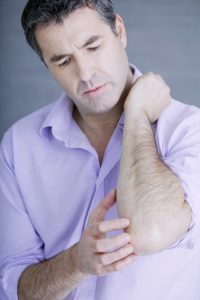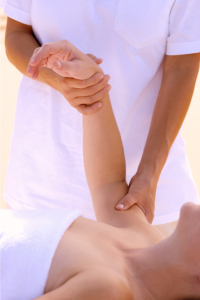Do you have problems with your elbow?
When you suffer from a painful and stiff feeling in one of your elbows, this does not necessarily mean that you have arthritis. The elbow is a delicate joint that can be overloaded these days, with intensive sports practice and the use of electronic gadgets. Common elbow injuries include a golf elbow, a tennis elbow, and RSI, with the tendons or tendon attachment sites being inflamed. The issues can be a result of bursitis, rheumatism, rheumatoid arthritis or through the cubit tunnel syndrome, with a nerve on the inside of the arm being irritated. With continued pain and stiffness in the elbow, it is always wise to make an appointment with the GP in order determine the exact cause of the symptoms.
This is how the elbow is constructed
The elbow is a special joint. It connects one bone in the upper arm with two bones in the forearm. This not only makes it possible to bend the arm but also to rotate the two bones in the forearm relative to each other. A layer of cartilage coats the joints of the elbow to allow the joints to slide smoothly over each other. Biceps (muscles) run from the front of the upper arm, which enables the arm bend and rotate. The triceps (muscles) on the back of the elbow and upper arm enable the arm to extend. The elbow joint has ligaments that provide the necessary rigidity.
Cause of arthritis in the elbow
Osteoarthritis in the elbow joint does not occur frequently. This joint is not very heavily loaded during movement. In this case, the tendons may be under considerable strain by repetitive movements. As a result, they can become irritated or inflamed. When the GP or specialist attributes pain and stiffness to cartilage wear, arthritis is usually to blame. In the case of cartilage wear, the underlying bone is partially exposed. Also, the cartilage can be damaged by an inflammatory reaction, such as rheumatoid arthritis. Usually rheumatoid arthritis occurs in both elbows.
Finally, arthritis may develop after a fracture in the elbow joint. This type of arthritis can occur years after the damage.
Symptoms of arthritis in the elbow
The first symptoms of osteoarthritis in the elbow are pain during movement, and strain on the joints. There may also be stiffness after a period of rest. The stiffness disappears once you move again. Sometimes the elbow becomes immobile, and you may have issues bending and stretching. This can cause problems with eating and might limit personal care. The joints may become inflamed by loose pieces of cartilage. An inflamed elbow hurts and becomes swollen.
Diagnosis osteoarthritis in the elbow
For the diagnosis of osteoarthritis in the elbow an X-ray is usually sufficient. Your doctor can see the decrease in the thickness of the cartilage and the irregular shape of the joint on an X-ray.
Treatment of arthritis in the elbow
With beginning arthritis, the doctor will usually refer you to a physical therapist. He can help you to keep the muscles around the elbow joint flexible and strong by using exercises. Arthritis patients with well-trained muscles around a worn joint often have less pain. Also, the physical therapist can help to improve the elbow’s mobility. In addition, the doctor may prescribe drugs to combat the pain.
Usually your doctor will first prescribe acetaminophen for pain relief. If this does not work properly, your doctor may then prescribe NSAIDs. However, many nasty side effects accompany this pain relieving and anti-inflammatory drug for many patients.
Therefore, some people with arthritis use the natural alternative: Liquid Green-Lipped Mussel in combination with Bio-Curcumin. These are natural pain relievers and inflammatory inhibitors with a similar effect to NSAIDs, although slower. We have rarely seen reports of unwanted side effects during the use of this liquid combination of Green-lipped mussel and Bio-Curcumin. In addition, this supplement is available without a prescription from the independent pharmacies, health stores, and online.
Sometimes the doctor may also choose to inject the elbow with a corticosteroid, which only symptomatically relieves the pain.
In advanced forms of arthritis, your doctor may suggest surgery. During an endoscopic procedure, the surgeon can remove pieces of loose cartilage and smooth rough edges. This reduces the pain and swelling. The surgeon may also decide to punch small holes in the bone under the cartilage during such an endoscopic procedure. As a result, scar tissue will fill the holes in the cartilage. This improves joint function and reduces the pain. In case of severe wear of the elbow joint, a prosthesis may be implanted.
Exercises for patients with osteoarthritis in the elbows
Below is an exercise program to strengthen the muscles of the elbows and improve the mobility of your joints. You should do each exercise in a series of three. Always take 30 seconds after each series.
Exercise 1:
Sit on a chair with your hands on the upper legs. Move your hands to the shoulders by bending the elbows. Hold this position for a few seconds and return your arms back to the starting position.
Exercise 2:
Sit on a chair with your hands on the upper legs. Move your arms forward by stretching the elbows. Hold this position for a few seconds. Return to the starting position again.
Exercise 3:
Sit beside the table with your forearms on the table and with your palms down. Turn your palms up, but keep your elbows on the table. Hold this position for a few seconds then bring your palms back to the starting position.

Share this page
Tweet

Download for free the booklet ‘Moving without pain’ with a retail value of $6.75 / £4.95.
Any questions? Please feel free to contact us. Contact us.







